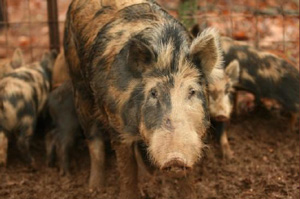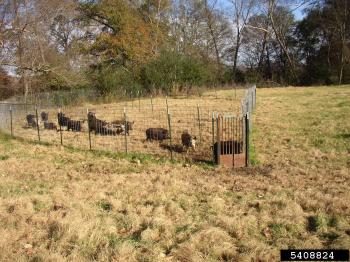How to Get Rid of Feral Hogs
Feral hogs (Sus scrofa) are everywhere in Arkansas. These non-native invaders likely escaped from a farm or were released for sport hunting. After a generation or two, progeny of a domesticated hog appear untamed, with thickened fur and tusks. Sows produce an average six piglets per litter when 8 to 13 months of age,with 1 to 2 litters per year, for a lifespan of 5 to 8 years. Other than hunters, research indicates feral hogs have few predators once past 10 to 15 pounds.
Their feeding and wallowing behaviors create a number of problems, including agriculture crop loss, pasture damage, wildlife habitat loss, water pollution (e.g., sedimentation, transmission of E. coli), and disease transmission to livestock and in rare cases, people. Non-native feral hogs compete directly with native wildlife species for limited food supplies, disturb habitat, and consume small mammals and reptiles, the young of larger mammals (e.g., fawns), and eggs and young of ground-nesting birds (e.g., bobwhites, wild turkey).
Watch a video clip of a pasture rooted up by feral hogs
Although small herds of feral hogs have lived in Arkansas for generations, the feral hog population in the state has increased and expanded dramatically since the 1990's. Controlling the prolific feral hog has proven difficult. Feral hogs are very adaptive and learn to avoid hunters and traps. Hogs are very mobile, and will range for miles in search of food and mates. Most feral hogs are nocturnal, and therefore often unseen until signs appear. Signs of feral hogs are rooting, tracks, wallows, nests or beds, tree and post rubs.
Watch a video clip of a feral hog wallowing
Who to call for help with feral hogs
#1. USDA APHIS Wildlife Services – Arkansas
USDA – Wildlife Services offers assistance to private landowners statewide experiencing feral hog damage. They have a number of employees dedicated to assisting landowners with trapping and removing feral hogs, and in some instances aerial shooting. To request assistance with feral hogs on your property, call Robert Byrd at 501-835-2318.
#2. Other agencies and organizations:
- Arkansas Conservation Districts. A pilot project funded by the United States Department of Agriculture and the Arkansas Department of Agriculture has enabled Conservation Districts to provide feral hog trappers for a limited time to assist landowners in selected counties in the state. Contact USDA – Wildlife Services first (above), as these Conservation District trappers work in coordination with them. Optionally, contact your local Conservation District office.
- Arkansas Farm Bureau. A few local offices have traps available on loan to members. Contact your county Farm Bureau office and ask if they have a trap loan program, https://afbic.com/find-an-agent/
- Arkansas Game and Fish Commission. Private Lands Biologists write wildlife plans and a number of other duties, which occasionally includes assisting landowners with trapping feral hogs because of their destruction of wildlife habitat. Contact USDA – Wildlife Services first (listed above) before contacting a Private Lands Biologist.
- UNIVERSITY OF ARKANSAS SYSTEM DIVISION OF AGRICULTURE, COOPERATIVE EXTENSION SERVICE. Yes, contact us for your educational needs! County Extension Agents conduct workshops, site visits, and trap demonstrations with landowners and their neighbors who are interested in learning and participating in educational programs about feral hog control.
- U.S. Fish & Wildlife Service or U.S. Forest Service. If you own property adjacent to public lands, a federal agency may work with landowners to extend forest and wildlife management practices onto private lands. Such assistance may include aerial shooting of feral hogs, which is led by USDA – Wildlife Services in Arkansas. Call Wildlife Services first (above) or your local federal office to discuss options.
DYI options for feral hogs
None of the following methods for removing feral hogs have proven 100% effective, though corral trapping is recommended as the most efficient for removing large numbers. Using several strategies, for example corral trapping followed by night shooting and dog-hunting stragglers, could be your best option for achieving population reduction. Each situation is unique. Contact the agencies listed above, or your local County Extension Agent, to discuss your particular circumstance.
- Corral trapping captures multiple hogs in a sounder or bachelor group at one time and is considered the most effective method for removing feral hogs. Trapping requires a strategy that involves a significant investment of time and equipment. Traps which capture only one feral hog or a portion of the group should be avoided, as non-trapped hogs are now "educated" to avoid traps. Trap-shy hogs soon reproduce and problems return.
- Night Shooting with a thermal scope and suppressor can be effective for removing feral hogs a few at a time, especially those which are reluctant to enter traps.
- Hunting with dogs can remove single boars or stragglers who won't enter the trap. Because typically only one hog is removed at a time and the rest are scattered, it is not recommended for population control.
- Snaring can be used to supplement corral trapping. Snares can be placed around corral fences and along trails. Beware that snares can capture non-target wildlife and require frequent checks. Contact your local wildlife officer about laws regarding snares.
- Daylight Shooting a few feral hogs in a group does little to control their numbers and typically "educates" survivors to avoid humans. If implementing a trapping program, do not shoot or otherwise disturb hogs from your trapping area. After your trapping program, shooting or dog hunting can be effective at removing the remaining hog or two which refuses to be trapped.
Strategy for capturing feral hogs
- Conduct surveillance over bait piles using trail (game) cameras. Learn how many hogs and of what size, and their behaviors.
- Train feral hogs with bait to return regularly to the site.
- Set the corral trap when hogs appear regularly on camera. If necessary, use bait to move feral hogs to an open spot before setting up the trap.
- Watch on camera how feral hogs behave around the trap. Are they nervous? If so, remove a few panels until they are comfortable approaching the bait. Fence panels with 4-inch squares or smaller are recommended for capturing smaller piglets.
- Once the corral trap is set up, be patient. All hogs in the group should enter the trap quickly on camera before setting the trigger.
- Removing the whole sounder is recommended to avoid educating uncaught hogs.
Additional details are available from resources below.
For more information about feral hogs, local trapping demonstrations, upcoming workshops, or having a workshop in your community, contact your local county Extension office.
What are Arkansas laws about feral hogs?
- It is legal to shoot or trap feral hogs, day or night, on privately-owned land.
- Public lands including federal refuges and Wildlife Management Areas (WMAs) have different rules about feral hogs, and therefore check the rules first.
- Feral hogs must be killed immediately upon capture.
- It is illegal to possess, sell, transport, or release hogs.
- If located in a Chronic Wasting Disease (CWD) Zone, special permission is required from the Arkansas Game and Fish Commission to use bait outside hunting season for nuisance wildlife control, such as attracting feral hogs into a corral trap. Check hunting regulations at the Arkansas Game and Fish Commission website or contact your local wildlife officer.
For details about feral hog laws, contact the Arkansas Game and Fish Commission or read the fact sheet Laws and Regulations Governing Feral Hogs in Arkansas.
University of Arkansas Publications
-
Feral Hog Control in Arkansas Information about feral hogs and their life history, identifying sign, an overview of different control options, and tips and tricks for capturing and removing feral hogs from your property. -
Although cellular trapping systems provide the greatest trapping efficiency, they can be cost prohibitive for some landowners wanting to control feral hogs on small acreages. This publication describes in detail a procedure for capturing feral hogs without educating them - while on a budget.
- Laws and Regulations Governing Feral Hogs in Arkansas
Laws governing feral hogs are regulated by the Arkansas Livestock and Poultry Commission, with Arkansas Game and Fish Commission regulating hunting aspects. -
Natural decomposition, composting, and human consumption (when following safe practices) are options for disposing of feral hog carcasses.
-
Information about symptoms, treatment, transmission and safety measures concerning this disease.
-
Results from a statewide survey of landowners compare damages to those who own pasturelands, forestland, and cropland in areas with estimated high, moderate, and low populations of feral hogs in the state.
-
Perceptions of County Agriculture Agents about Feral Hogs in Arkansas Results from a survey conducted in December 2013. -
Arkansas Resources
- Arkansas Feral Hog Eradication Task Force
- Arkansas Feral Hog Handbook Available for download, or paper copies can be ordered online at the task force website, or at your local County Extension Office.
-
Arkansas Game and Fish Commission -
Arkansas Livestock and Poultry Commission
Other Resources
National eXtension Resources
|
| The Jack H. Berryman Institute |
| Centers for Disease Control |
Mississippi State University
|
The Samuel Roberts Nobel Foundation
|
Texas A&M AgriLife Extension
|
|
USDA Animal and Plant Health Inspection Service
|

